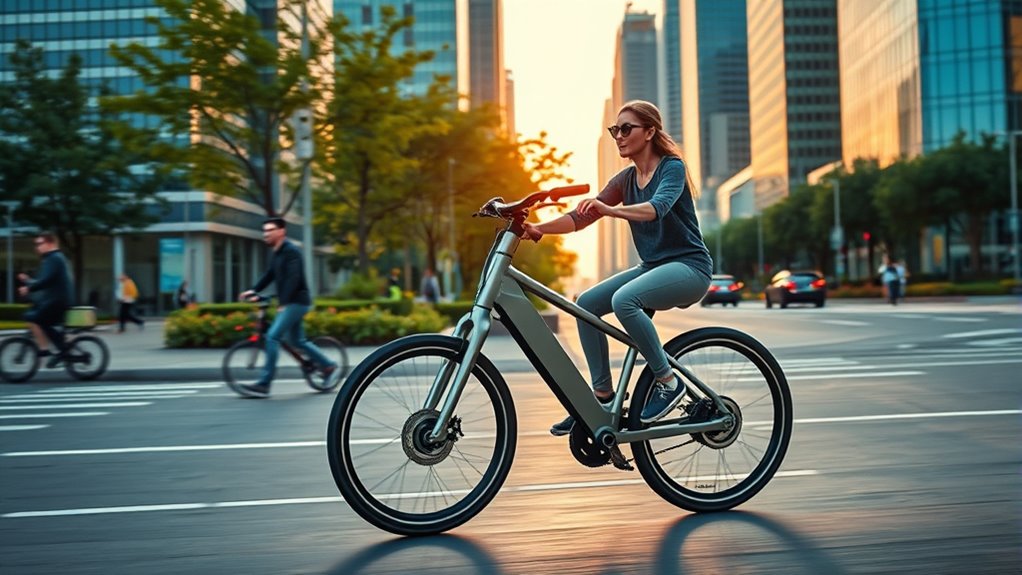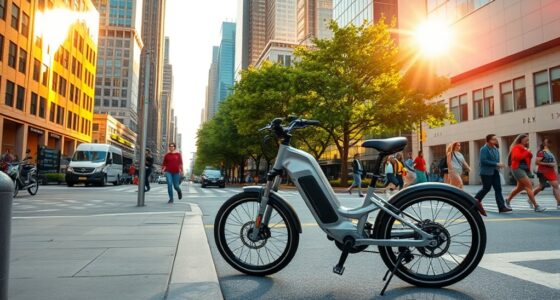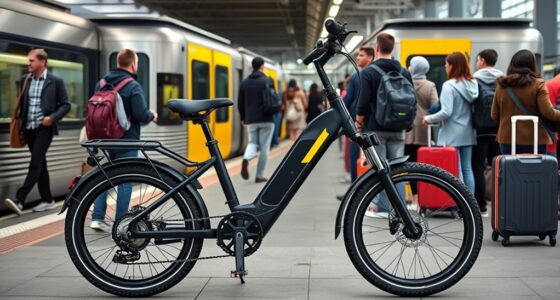By 2026, commuter e-bikes will be more affordable, thanks to advances in battery tech like longer ranges and rapid charging. You’ll see more city investments in protected lanes and charging stations, making riding safer and more convenient. Expect smarter designs with lightweight batteries and seamless integration into public transit. These trends will make e-biking a practical, sustainable choice for urban travel. Stay with us to discover how these innovations will transform your daily commute.
Key Takeaways
- Continued infrastructure investments will make e-bike commuting safer, more convenient, and seamlessly integrated with public transit systems.
- Advancements in battery technology will enable longer ranges, faster charging, and more affordable e-bikes.
- Urban redesigns will prioritize protected lanes and charging stations, boosting e-bike adoption.
- E-bikes are expected to become the primary urban commuting mode by 2026 due to technological and infrastructural improvements.
- Widespread adoption will significantly reduce urban pollution, congestion, and enhance overall city livability.

Have you wondered how commuter e-bikes are shaping the future of urban transportation? As cities grow denser and traffic congestion worsens, e-bikes are becoming crucial in transforming how people move around. One key factor driving this change is the evolution of urban infrastructure. Cities are increasingly investing in dedicated bike lanes, secure parking, and seamless integration with public transit systems. These developments make riding commuter e-bikes safer and more convenient, encouraging more people to choose two wheels over cars. Expect to see urban planning prioritize bike-friendly designs, making it easier to navigate busy streets and reducing reliance on traditional vehicles. This infrastructural shift is essential because it not only supports the growth of e-bike usage but also helps to reduce pollution and traffic jams, creating more livable cities. Additionally, integrating advanced projector technology into urban planning tools can enhance infrastructure design and efficiency.
Battery innovations are another major trend shaping the future of commuter e-bikes. Advances in battery technology mean longer ranges and faster charging times, addressing one of the biggest barriers to widespread adoption. Newer batteries offer higher energy densities, allowing you to travel further without worrying about running out of power. Some manufacturers are experimenting with lightweight, flexible batteries that can be integrated more discreetly into bike frames, enhancing both aesthetics and functionality. Additionally, rapid charging capabilities mean you can top off your e-bike quickly during a short break, making daily commutes more efficient. As battery costs continue to decline, expect e-bikes to become more affordable, broadening their appeal across various income levels and urban environments.
The combination of improved urban infrastructure and cutting-edge battery innovations is setting the stage for a new era in city commuting. You’ll likely see cities actively redesigning their transportation landscape to support these bikes, with more protected lanes and integrated charging stations. Meanwhile, the ongoing development of lightweight, powerful batteries ensures that e-bikes will become more reliable and user-friendly. These technological and infrastructural advances will make commuting easier, faster, and more sustainable, encouraging many to ditch cars altogether. By 2026, you might find that riding an e-bike isn’t just an eco-friendly option but the most practical, efficient way to navigate urban life. The synergy between smarter infrastructure and better batteries is making the future of commuter e-bikes bright, transforming how you and countless others get around every day.
Frequently Asked Questions
Will E-Bike Prices Decrease Significantly by 2026?
You might wonder if e-bike prices will drop considerably by 2026. Pricing trends suggest that increased market competition and technological advancements could lead to more affordable options. As more brands enter the market, competition drives prices down, making e-bikes more accessible. However, factors like supply chain issues or new features could influence prices. Overall, expect some decrease, but the extent depends on these evolving market conditions.
How Will Infrastructure Developments Impact E-Bike Commuting?
You’ll notice that infrastructure developments, like improved urban planning and traffic management, make e-bike commuting safer and more convenient. Cities investing in dedicated bike lanes and better traffic flow encourage you to switch from cars to e-bikes, reducing congestion and pollution. These changes create a more seamless and enjoyable riding experience, motivating you to choose e-bikes for daily commutes, ultimately transforming urban mobility and making your commute quicker and more eco-friendly.
What Are the Latest Safety Features in Future E-Bikes?
You’ll notice that future e-bikes come equipped with advanced safety features like smart sensors that detect obstacles and automatically alert you. Many models will include automatic braking systems that activate when a collision risk is detected, giving you extra protection. These innovations aim to make your rides safer and more efficient, giving you confidence on busy streets and helping you avoid accidents before they happen.
Will There Be New Battery Recycling Regulations?
You’ll likely see new regulations on battery recycling, as governments aim to improve environmental standards. These rules could enforce stricter regulatory standards for e-bike batteries, encouraging manufacturers to develop more sustainable recycling methods. It’s a proactive move to reduce e-waste and protect ecosystems. Staying informed about these changes helps you understand your responsibilities and benefits, ensuring you contribute to eco-friendly practices while enjoying your e-bike commute.
How Will E-Bike Integration With Public Transit Evolve?
You’ll see e-bike integration with public transit improve as cities tackle urban congestion and promote environmental sustainability. Expect more bike-friendly stations, seamless fare systems, and shared e-bike programs that make commuting smoother. These innovations encourage you to ditch cars, reduce emissions, and navigate crowded streets efficiently. As transit options become more interconnected, you’ll find e-bikes an essential part of your eco-conscious, hassle-free daily commute.
Conclusion
As you look ahead to 2026, the rise of commuter e-bikes is set to transform urban travel. With over 40% of city commuters considering e-bikes as their primary mode of transport, it’s clear they’re becoming essential. Embrace these trends now, and you’ll enjoy faster, greener, and more affordable commutes. The future’s bright for e-bike enthusiasts—are you ready to ride the wave? Your next journey could be just a pedal away.








